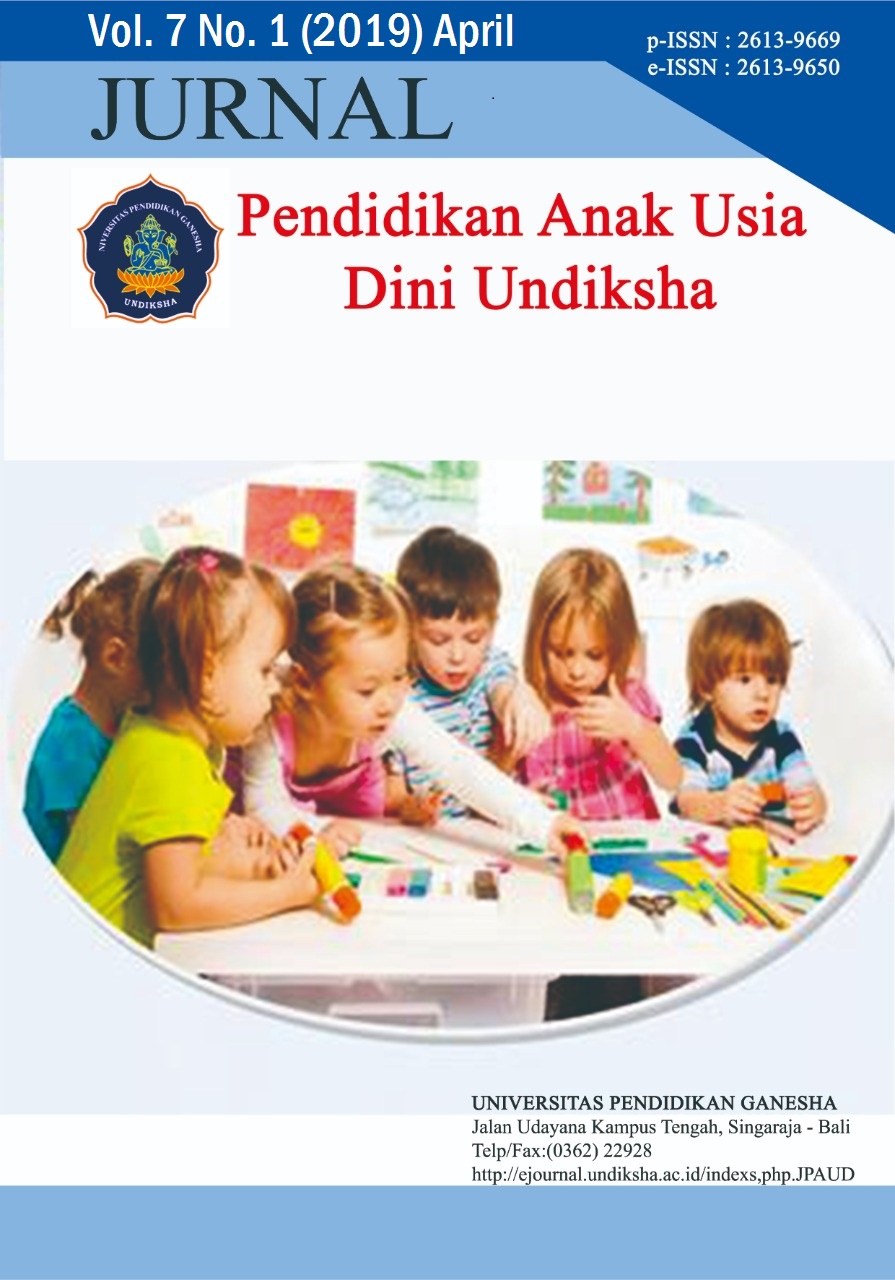PENGARUH METODE BERCERITA BERBASIS KEARIFAN LOKAL TERHADAP KEMAMPUAN EMPATI ANAK KELOMPOK B1 TK TUNAS DAUD KECAMATAN DENPASAR BARAT TAHUN AJARAN 2018/2019
DOI:
https://doi.org/10.23887/paud.v7i1.18761Abstract
Penelitian ini bertujuan untuk mengetahui pengaruh metode bercerita berbasis kearifan lokal terhadap kemampuan empati anak kelompok B1. Penelitian ini merupakan penelitian Pre-Experimental Design dengan desain One-group pretest-posttest. Populasi dalam penelitian ini adalah seluruh anak kelompok B1 TK Tunas Daud Kecamatan Denpasar Barat jumlah 20 anak. Sampel penelitian ditentukan dengan teknik purposive sampling, sehingga diperoleh kelompok B1 sebanyak 19 anak. Hasil dari penelitian ini yaitu data kemampuan empati anak menunjukkan rata-rata pre-test 54,31 , sedangkan nilai rata-rata post-test 89,63 dan diperoleh nilai thitung sebesar 14,07. Pada ttabel dengan kriteria signifikansi 5% dengan dk = 18 menunjukkan nilai 2,101. Sehingga data kemampuan empati menunjukkan bahwa thitung > ttabel. Maka dapat disimpulkan metode bercerita berbasis kearifan lokal berpengaruh terhadap kemampuan empati anak kelompok B1 TK Tunas Daud Kecamatan Denpasar Barat Tahun Ajaran 2018/2019. Berdasarkan simpulan tersebut, maka disarankan kepada peneliti lain agar dapat menggunakan metode bercerita berasis kearifan lokal sebagai metode pembelajaran dalam membentuk kemampuan empati anak.Kata Kunci : Kata kunci : metode bercerita, berbasis kearifan lokal, kemampuan empati, anak usia dini
This study refers to an understanding of the methods described based on local wisdom on the ability of empathy for children in group B1. This research design study is Pre-Experimental with a One-group pretest-posttest design. The population in this study were all children in group B1 TK Tunas Daud West Denpasar Subdistrict, there were 20 children. The research sample was determined by purposive sampling technique, so that B1 group was obtained as many as 19 children. The results of this study are data on children's empathy ability showing an average pre-test of 54,31, while the average value of post-test is 89.63 and the value of tcount is 14,07. At ttable with a significance criterion of 5% with dk = 18 indicating the value of 2.101. So the data on empathy ability shows that t count> t table. Then it can be concluded that the method of storytelling based on local wisdom influences the ability of empathy in the children of B1 group TK Tunas Daud, West Denpasar District, Academic Year 2018/2019. Based on these conclusions, it is recommended that other researchers be able to use the method of storytelling based on local wisdom as a learning method in shaping children's empathy abilities.
keyword : Keywords: stories telling method, based on local wisdom, empathy ability, early childhood
Downloads
Published
2019-07-21
How to Cite
., D. S. D. N. P., ., L. A. T. S., & ., D. N. N. G. M. (2019). PENGARUH METODE BERCERITA BERBASIS KEARIFAN LOKAL TERHADAP KEMAMPUAN EMPATI ANAK KELOMPOK B1 TK TUNAS DAUD KECAMATAN DENPASAR BARAT TAHUN AJARAN 2018/2019. Jurnal Pendidikan Anak Usia Dini Undiksha, 7(1), 78–87. https://doi.org/10.23887/paud.v7i1.18761
Issue
Section
Articles
License
Authors who publish with the Jurnal Pendidikan Anak Usia Dini Undiksha agree to the following terms:
- Authors retain copyright and grant the journal the right of first publication with the work simultaneously licensed under a Creative Commons Attribution License (CC BY-SA 4.0) that allows others to share the work with an acknowledgment of the work's authorship and initial publication in this journal.
- Authors are able to enter into separate, additional contractual arrangements for the non-exclusive distribution of the journal's published version of the work (e.g., post it to an institutional repository or publish it in a book), with an acknowledgment of its initial publication in this journal.
- Authors are permitted and encouraged to post their work online (e.g., in institutional repositories or on their website) prior to and during the submission process, as it can lead to productive exchanges, as well as earlier and greater citation of published work. (See The Effect of Open Access)











